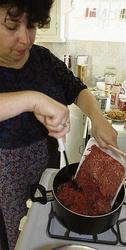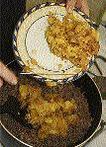
The ground beef is placed into the pot. - photos by Rosemary Parkinson Rosemary Parkinson, Gleaner Writer
Last week Elinor Sisulu, author of Walter and Albertina Sisulu - In Our Lifetime, prepared South African oxtail and butter beans. This week, Helen Moffet prepares bobotie that hails from the Western Cape where early Dutch settlers brought Indonesian slaves; their spices and fruits in tow.
At the end of the ICC Cricket World Cup, we were all gathered at the home of Dominican couple Joey and Patsy Peltier in Barbados cooking for a crowd of Caribbean and South African cricket aficionados. Joey is the regional specialist in sustainable rural development for Inter-American Institute for Cooperation in Agriculture (IICA). Helen sauted the onions until clarified, adding three cloves of finely chopped garlic. With the onions clarified, she added two cloves of garlic, a heaped teaspoon of freshly grated ginger to the pan. Once this was sauted, a teaspoon of cinnamon, half of grated nutmeg, two of ground coriander seed, one of cumin and one of clove went in. "You can substitute all these spices with mild curry powder and cinnamon," she said as the aroma of onions and garlic changed into a harmonious spice fragrance. Two pounds of seasoned ground beef was added and cooked gently before setting aside.
HELEN WOOLMER
Helen, who also ghost authored the late Bob Woolmer's book, was born in apartheid South Africa. "We were white but poor; sometimes there wasn't enough to pay our school fees. There was a very complicated poor white class ' Afrikaan' - a word describing the descendants of Dutch settlers but also a language - the single most important language in South Africa today. Because my mother taught us all to speak proper English, we were considered posh."
Helen kept close to 'the apartheid barometer' - news of how many children/people had died in detention, how many had been reclassified under The Population Registration Act. "It was a most disgusting period of South African history but the wings of freedom came through after a tough journey."
THE BOBOTIE TAKES SHAPE
"There's a bevy of deciduous fruit in South Africa so we tend to make a lot of jams, jellies and chutneys. Take a pound of fruit - I'm using apple, peeled, cored, cut into chunks, a quarter cup of sugar, one cup water, a quarter cup apple cider vinegar, the Cape Mix - ginger, coriander, clove and cinnamon. One can add mint or red chilies.
Boil together until fruit is cooked, the mixture looking like a chunky chutney. While this is cooking on a low fire, let's have a cup of Rooibos tea." Both Elinor and Helen recollected the old time Welcome Dover stove, saying almost in unison "the one with the iron plates heated by burning wood underneath."
I remembered seeing those stoves in Trinidad and even Jamaica. "Rooibos is a shrub with needle-like leaves - indigenous to a specific geographic site growing nowhere else - that comes from fynbos (finebush) a generic term for 400 different kinds of plants. Drunk by the original people of The Cape, discovered in the '70s by the white upper class, it's an amazing health tea filled with anti-oxidants, now packaged as Redbush and sold worldwide. My grandmother kept a pot boiling daily on that Welcome Dover, adding water and leaves as the red liquid diminished in colour.
COOLING TEA
I don't use sugar anymore,substituting with Xylo or Xylitol, a natural occurring sugar commonly derived from corncobs and birch trees endorsed by the European Dental Association." The tea was cooling and pleasant.
Helen next added a cup of her apple chutney to the mince: "Mix carefully, placing same into a rectangular, buttered casserole dish." Once done, she began beating two eggs in a bowl; salt and pepper added; a pinch of cinnamon, a splash of milk; the mixture was poured carefully over the meat, a bay leaf floated on the top.
The casserole was then placed into a 375 degree oven for 20 minutes until "the custard on the top sets completely." Later, removing it from the oven, Helen smiled, in that amazing South African singing accent said: "Beautiful. Nice and brown, you can cut it like a macaroni pie. The chutney within makes this dish extra special."
South African yellow rice to be served with last week's South African oxtail and butter beans and bobotie.
One cup rice, two and half cups water, two teaspoons salt, half to one teaspoon turmeric, one or two cardammon kernels, stick of cinnamon. Boil until rice is cooked adding raisins, fresh garden peas and flaked almonds.
Next week: Dominican Patsy Peltier cooks up a storm while we learn how all three women met.

The fruit is added to the beef.

Egg mixture is poured over the mince and fruit-like a topping.

Ingredients are gently stirred.

Helen with her finished bobotie.

